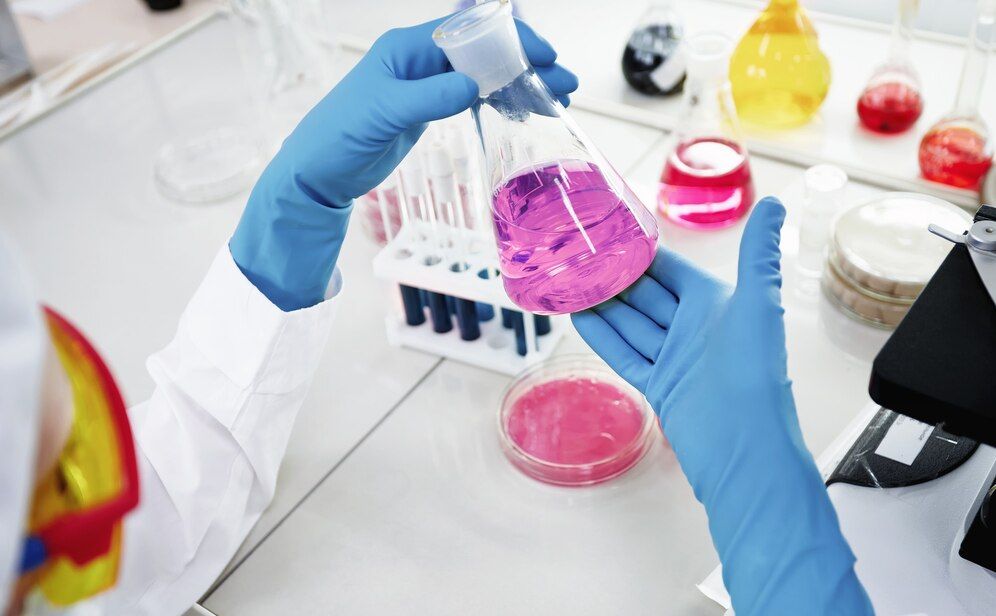contact@monad.com.cn
WhatsApp: +86-13967172554

Contact Us
What Does Gas Chromatography Do to the Mixture of Solvents?
But what does gas chromatography separate based on and how are compounds separated in the gas chromatography process? If you want to know the answers to these questions, follow us, this blog will answer everything you want to know about gas chromatography separation technology.
What Does Gas Chromatography Do to the Mixture of Solvents?
Gas chromatography (GC) is a powerful analytical technique that separates and analyzes components of a complex mixture of solvents. In gas chromatography, the mixture is vaporized and injected into a chromatograph, which consists of a column and a detector. The column is a long, coiled tube typically coated with a stationary phase, and it serves as the separation medium. As the vaporized mixture travels through the column, different components interact with the stationary phase at varying rates, causing them to separate based on their molecular characteristics. The detector then identifies and quantifies these separated components as they elute from the column. Gas chromatography is widely used in various fields, including chemistry, forensics, environmental science, and pharmaceuticals, providing precise and efficient analysis of complex mixtures.
Types of Compounds Which are Suitable for Analysis Using GC
GC is a versatile analytical technique that is particularly well-suited for the analysis of volatile and semi-volatile compounds. Compounds suitable for analysis using GC include hydrocarbons, fatty acids, alcohols, esters, ketones, aldehydes, and other organic compounds. This technique is especially valuable in areas such as environmental analysis, food and flavor profiling, pharmaceutical research, and forensic science. Substances with low molecular weights, low polarity, and sufficient volatility are ideal candidates for GC analysis. The method's sensitivity and speed make it a preferred choice for laboratories requiring precise separation and quantification of components within a given sample.
What Does Gas Chromatography Separate Based on?
The basis of separation in gas chromatography lies in the differential interaction of compounds with the stationary phase within a chromatographic column. Gas chromatography operates on the principle of partitioning, exploiting the varying affinities of different compounds between the mobile (gaseous) and stationary phases. As the sample is injected into the instrument, it vaporizes and is carried by a carrier gas through a column with a stationary phase. The efficiency of separation is determined by the interaction of individual components with the stationary phase. Compounds with higher boiling points, greater polarity, or stronger interactions with the stationary phase take longer to traverse the column, resulting in longer retention times. Conversely, those with lower boiling points or weaker interactions move more rapidly through the column, leading to shorter retention times.
Factors Affecting Separation in Gas Chromatography Factors affecting separation in gas chromatography are critical considerations for achieving optimal results in the analysis of complex mixtures. Several key factors influence the efficiency and precision of the separation process:
1. Vapor Pressure: The boiling point of a compound is linked to its polarity, and lower boiling points result in higher vapor pressure. This relationship affects retention time, with lower boiling solvents aiding in quicker transitions to the gas phase.
2. Polarity of Components vs. Stationary Phase: Similar polarities between the stationary phase and compounds lead to longer retention times due to stronger interactions. Polar compounds exhibit longer retention times on polar stationary phases but shorter ones on non-polar columns.
3. Column Temperature: Excessive temperatures can diminish retention times and compromise separation quality. Optimal separations often occur with temperature gradients, utilizing differences in polarity and boiling points.
4. Carrier Gas Flow Rate: Higher flow rates reduce retention times but can result in poor separation. Adequate interaction time between components and the stationary phase is essential for effective separation.
5. Column Length: Longer columns generally enhance separation but can lead to increased retention times and peak broadening. Optimal column length considers trade-offs between separation quality, retention time, and peak broadening.
6. Amount of Material Injected: Injecting an appropriate amount of material ensures symmetrical peak shapes. Overloading the column can cause significant tailing, affecting separation quality, and, typically, only a small percentage of the injected material passes through the column.
How are Compounds Separated in the Gas Chromatography Process?
In the gas chromatography process, compounds are separated based on the principle of "like-dissolves-like." This chromatographic technique involves both a mobile phase (carrier gas) and a stationary phase, typically a packed column or a coated capillary column. The mobile phase, composed of inert gases like helium, argon, or nitrogen, facilitates the movement of the compounds through the column. The stationary phase, either the packing material itself or a high-boiling liquid coating, interacts differently with each compound. The strength of interaction determines the retention time, with stronger interactions leading to longer retention times. As the mixture migrates through the column, components with stronger interactions take more time to pass through, resulting in separation. The detector identifies each compound, generating electronic signals that are recorded and plotted, with the area under the peak proportional to the injected amount. This process provides valuable insights into the composition of complex mixtures.
Conclusion
In conclusion, GC stands as a powerful analytical tool for separating and analyzing complex mixtures of solvents. By utilizing a mobile phase and a stationary phase, GC takes advantage of the "like-dissolves-like" principle, enabling the efficient separation of compounds based on their molecular characteristics. The method is particularly well-suited for volatile and semi-volatile compounds, making it invaluable in various fields such as environmental analysis, food profiling, pharmaceutical research, and forensic science. If you want to learn more about Gas Chromatography, come to Monad and consulate our experts!


